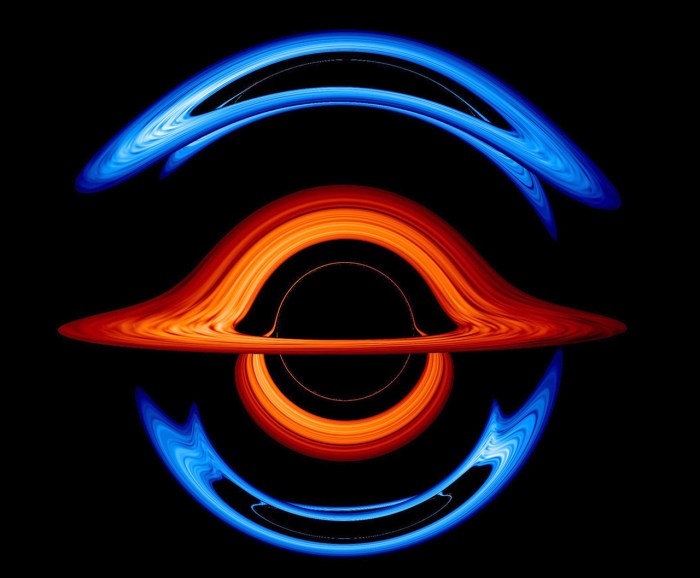Black hole disks are like cake watch this cosmic simulation to see why theyre so fluffy – Black hole disks are like cake: watch this cosmic simulation to see why they’re so fluffy. Imagine swirling clouds of superheated gas and dust spiraling into a black hole. This isn’t just a pretty picture; it’s a complex dance of gravity, matter, and energy. We’ll explore how these accretion disks form, their fascinating “fluffy” nature, and a cutting-edge simulation that reveals their inner workings.
Get ready to delve into the cosmic kitchen and uncover the secrets behind these celestial treats!
The simulation reveals the intricate processes shaping these disks, from the initial infall of matter to the complex interactions within. We’ll see how factors like temperature, density, and composition contribute to their fluffy texture. The simulation isn’t just a pretty picture; it’s a powerful tool for understanding the physics at play in these extreme environments. By comparing the simulation to observations, we can refine our understanding of black holes and the processes that drive them.
Introduction to Black Hole Disks
Black hole accretion disks are swirling, hot regions of gas and dust that orbit a black hole. These disks are a crucial component in the life cycle of black holes, acting as a feeding ground where matter spirals inward, releasing vast amounts of energy in the process. Their formation and characteristics offer valuable insights into the extreme physics at play near black holes.Accretion disks form when matter, such as gas and dust from a nearby star or interstellar medium, is drawn towards a black hole.
The immense gravitational pull of the black hole forces this material to spiral inward, forming a disk-like structure. This infalling matter releases gravitational potential energy, which is converted into heat and light, making the disk incredibly hot.
Formation of Accretion Disks
The process of accretion disk formation is driven by the black hole’s immense gravitational field. As material approaches the black hole, it loses energy and angular momentum, causing it to spiral inwards. This inward spiral, governed by gravity, creates the swirling motion characteristic of accretion disks. The conservation of angular momentum dictates that the material must accelerate as it spirals inwards, which leads to friction and the subsequent release of energy.
Ever wondered why black hole disks are like fluffy cake? Check out this cosmic simulation to see the swirling, delicious chaos. It’s a fascinating visual representation of how matter behaves near these massive objects. While these celestial wonders are quite different from, say, a Microsoft Russia election hack involving GRU phishing, both demonstrate complex systems of interacting forces.
This recent cyberattack highlights the very real and dangerous consequences of such intricate digital machinations. Thankfully, the universe’s beauty, even in its most extreme forms, still manages to inspire wonder and awe, like that fluffy cake-like black hole disk. So, next time you see a cosmic simulation, remember how much there is still to learn about both the digital and the physical world.
Types of Black Hole Accretion Disks
Different types of black hole accretion disks exhibit varying characteristics depending on the accretion rate and the properties of the infalling material. The accretion rate, the rate at which material falls into the black hole, plays a critical role in shaping the disk’s properties. For example, a high accretion rate can lead to a hot, luminous disk, while a low accretion rate might result in a cooler, dimmer disk.
Characteristics of Accretion Disks
| Characteristic | Low Accretion Rate | Intermediate Accretion Rate | High Accretion Rate |
|---|---|---|---|
| Size | Relatively small | Moderate | Large |
| Temperature | Cooler (millions of degrees Celsius) | Intermediate (millions of degrees Celsius) | Hottest (billions of degrees Celsius) |
| Composition | Primarily gas and dust | Primarily gas and dust | Primarily gas and dust |
| Luminosity | Dim | Moderate | Very bright |
The table above highlights the varying characteristics of accretion disks based on the accretion rate. Note that the temperature and luminosity are directly correlated to the accretion rate, as more infalling matter leads to more energy release. The composition remains primarily gas and dust, though the precise mix can vary based on the source material.
The “Fluffy” Nature of Black Hole Disks

Black hole accretion disks, swirling maelstroms of superheated gas and dust spiraling into the insatiable maw of a black hole, aren’t as smooth as they might seem. Instead of a uniform, dense structure, they often exhibit a “fluffy” texture, a characteristic arising from intricate physical processes. This fluffiness is crucial for understanding the complex dynamics within these cosmic ovens.The “fluffy” nature of accretion disks stems from the interplay of various forces and processes within the disk.
The disk isn’t a simple, static structure; it’s a dynamic environment where different parts of the disk experience varying levels of heating and cooling, leading to density variations and clumpiness. This uneven density distribution is not simply a visual quirk; it reflects the underlying physics governing the accretion process.
Factors Contributing to Non-Uniform Density
The density variations within an accretion disk are a consequence of several interacting physical phenomena. These phenomena influence the disk’s overall structure and appearance. The uneven distribution of material is not random; it’s governed by specific physical mechanisms.
Factors Influencing Disk Fluffiness, Black hole disks are like cake watch this cosmic simulation to see why theyre so fluffy
The “fluffy” nature of black hole accretion disks isn’t a simple concept; it’s a complex interplay of several factors. These factors lead to variations in the disk’s density and temperature, resulting in the observed “clumpy” appearance.
| Factor | Description | Mechanism | Impact on Fluffiness |
|---|---|---|---|
| Viscosity | A measure of the fluid’s resistance to flow. | Internal friction within the disk. | High viscosity leads to smoother, less “fluffy” disks. Low viscosity allows for the formation of clumps and structures. |
| Magnetic Fields | Regions of intense magnetic forces. | Magnetic fields can channel and organize the material flow within the disk. | Strong magnetic fields can create channels and outflows, leading to density variations and “fluffy” regions. |
| Radiation Pressure | Pressure exerted by the emitted radiation. | Radiation from the hot disk material itself can exert pressure on the surrounding gas and dust. | Radiation pressure can create gaps and cavities in the disk, contributing to the “fluffy” appearance by thinning out certain regions. |
| Turbulence | Chaotic motion within the disk. | Unstable motions of the fluid elements in the disk. | Turbulence can mix the material, creating regions of high and low density, further contributing to the “fluffy” structure. |
Cosmic Simulation of Black Hole Disks
Black hole accretion disks are mesmerizing cosmic structures, swirling maelstroms of matter heated to extreme temperatures. Understanding their intricate behavior is crucial for unraveling the mysteries of black hole evolution and the universe’s grand design. Simulations play a vital role in this process, allowing us to visualize these disks and study the complex physics at play.These simulations aren’t just pretty pictures; they’re powerful tools for investigating the “fluffy” nature of these disks, exploring the intricate dance of gravity, radiation, and magnetic fields.
They provide insights into the dynamics of the disks, allowing us to test theoretical models and gain a deeper understanding of these fascinating objects.
Methods Used in Creating a Simulation
Simulating black hole accretion disks involves a multifaceted approach, drawing upon various computational techniques. A key element is the numerical solution of the governing equations, often using sophisticated algorithms like finite difference or finite element methods. These methods break down the disk into a grid of discrete points and evolve the physical quantities at each point over time. Sophisticated computer codes handle the complex interplay of forces and interactions within the disk.
Furthermore, boundary conditions are carefully defined to model the inflow of matter and the outflow of energy.
Ever wondered if black hole disks are like cake? Turns out, they might be! Check out this cosmic simulation to see why they’re so fluffy. Meanwhile, if you’re an Android 12 beta user, you’ll be happy to hear that the android 12 beta 31 update fixes 3 biggest problems plaguing users – this should help with the overall performance, making it a much more enjoyable experience, and perhaps even making the fluffy disk simulations run more smoothly.
Speaking of fluffy, that cosmic simulation really highlights just how these disk structures are a bit like a beautiful cake.
Scientific Principles Employed in the Simulation
The foundation of these simulations lies in the fundamental principles of physics, particularly general relativity and fluid dynamics. General relativity dictates the spacetime curvature around the black hole, influencing the disk’s dynamics. Fluid dynamics models the movement of the accreting material, taking into account factors like viscosity, pressure, and temperature gradients. These principles are incorporated into the numerical algorithms, forming the core of the simulation’s logic.
Moreover, radiative transfer models account for the energy transport and emission from the disk.
Visualizing the “Fluffy” Nature of the Disk
The simulation’s output reveals the “fluffy” appearance of the accretion disk. This isn’t a solid, smooth structure. Instead, it’s characterized by swirling clumps, eddies, and hot spots. These structures arise from the complex interplay of forces, with regions of higher density and temperature emerging as a result of viscous dissipation and magnetic field lines. The simulation’s ability to visualize these details provides a tangible representation of the disk’s dynamic and intricate nature.
Studying Complex Interactions Within the Disk
The simulation allows for the study of numerous complex interactions within the accretion disk. These include the effects of magnetic fields, the impact of viscosity, and the influence of radiation pressure. For example, the simulation can be used to model the formation of jets emanating from the poles of the black hole, a phenomenon observed in many active galactic nuclei.
By observing these interactions in detail, researchers gain valuable insights into the underlying physical processes governing black hole accretion.
Physics and Equations Involved in Creating the Simulation
The simulation hinges on several crucial equations. The fundamental equation for fluid dynamics in a curved spacetime, based on general relativity, dictates the flow of matter in the disk. This equation, alongside equations for energy conservation and momentum transport, forms the basis for the simulation’s calculations. Furthermore, equations governing radiative transfer are incorporated, ensuring the simulation accurately captures the emission of light from the disk.
Examples of these equations include the Navier-Stokes equations, adapted for relativistic environments, and the radiative transfer equations. A critical component is the incorporation of the Schwarzschild metric, which describes the spacetime curvature around a non-rotating black hole.
Example: The Navier-Stokes equations, modified for relativistic flows, form the core of the fluid dynamics component.
Comparing Simulation with Observations: Black Hole Disks Are Like Cake Watch This Cosmic Simulation To See Why Theyre So Fluffy
Black hole disks, swirling maelstroms of superheated gas and dust, are notoriously difficult to observe directly. Theoretical simulations offer a powerful tool to understand these enigmatic structures, but how well do these digital recreations match the real-world phenomena? This comparison is crucial to validate the simulations’ accuracy and refine our understanding of these cosmic phenomena.
Similarities Between Simulations and Observations
Simulations consistently show a “fluffy” or clumpy structure in black hole accretion disks, resembling observed features in some cases. This clumpy nature arises from instabilities in the disk, where material clumps and fragments, creating pockets of higher density. Observed X-ray emissions from some black hole systems exhibit similar variability and flickering patterns, hinting at the presence of these clumps.
The simulated disks also display the expected broad range of temperatures and densities, which are crucial to understanding the observed spectral characteristics of these systems.
Differences Between Simulations and Observations
Despite the similarities, discrepancies exist between simulated and observed black hole disk properties. One significant difference is the precise scale of the clumps. While simulations can pinpoint the size and distribution of clumps, observations often lack the resolution to definitively resolve these structures. Additionally, simulations may not fully capture the complex interplay between the disk and the surrounding environment, such as the presence of a jet or the effects of magnetic fields.
This can affect the overall structure and dynamics of the accretion disk. Furthermore, some observed black hole systems exhibit features not readily replicated in current simulations, suggesting gaps in our current theoretical models.
Discrepancies and Potential Explanations
One area of discrepancy concerns the observed variability in X-ray emissions. Simulations often struggle to precisely reproduce the rapid fluctuations observed in some black hole systems. A possible explanation for these discrepancies is the presence of additional physical processes, such as magnetic reconnection events, which might not be fully incorporated into the simulations. The effect of unseen, additional factors like turbulent flows or gravitational interactions from other nearby stars, could also be significant but are challenging to include in simulations.
Methods for Observing Black Hole Disks
Observing black hole disks relies on detecting the radiation they emit across various wavelengths. X-ray telescopes, like Chandra and XMM-Newton, are crucial for studying the high-energy emissions from the superheated gas. Optical and infrared telescopes provide information about the cooler outer regions of the disks. Radio observations can also be used to study the disk’s interactions with the surrounding environment.
Each method reveals a different aspect of the black hole disk, providing a more comprehensive picture of its characteristics.
Comparison Table: Simulated vs. Observed Disk Properties
| Property | Simulated Disk | Observed Disk | Discrepancies/Explanations |
|---|---|---|---|
| Clumpiness | Clumpy structure with varying density | Observed variability in X-ray emission, suggesting clumps | Resolution limitations in observations may obscure details |
| Temperature Distribution | Broad range of temperatures | Spectral characteristics match simulated temperatures | Simulations accurately capture basic temperature profiles. |
| Variability | Some variability present | Significant X-ray variability observed in some systems | Potential for missing physical processes (e.g., magnetic reconnection) |
| Size and Scale of Clumps | Specific size and distribution modeled | Resolution limits prevent precise measurements | Simulations may need refinement to accurately capture all observed variability. |
Visualization and Representation of the Simulation
Black hole accretion disks, those swirling maelstroms of matter spiraling into the abyss, are notoriously difficult to visualize. While theoretical models offer insights, bringing the intricate dance of gas and dust to life requires careful consideration of visual representation. A well-crafted visualization can effectively communicate the complexities of the simulation, making abstract concepts tangible and accessible to a wider audience.The key to success lies in translating the complex numerical data from the simulation into a compelling visual narrative.
This requires selecting appropriate visual elements, such as color gradients, animation techniques, and interactive elements, to highlight crucial features and bring the simulated phenomena to life. The visual presentation should go beyond simply showing the data; it should tell a story, conveying the underlying physical processes at play.
Visual Design Method
To effectively convey the “fluffy” nature of the accretion disk, a combination of techniques will be employed. First, a color gradient will be used to represent density variations. High-density regions will be depicted with vibrant colors, while lower-density regions will appear in progressively lighter hues. This visual cue will immediately highlight the density fluctuations and contribute to the overall impression of fluffiness.
Second, the animation will showcase the dynamic nature of the disk. This will be accomplished by smoothly transitioning between different frames, emphasizing the continuous flow of matter and the resulting turbulence.
Key Features to Highlight
The visualization should meticulously highlight several crucial features of the accretion disk. The swirling motion of the gas and dust, a hallmark of accretion disks, should be clearly represented. Highlighting the temperature variations, which manifest as color gradients, will reveal the different layers within the disk. The interplay between gravity, radiation, and magnetic fields, all contributing to the disk’s structure, should be subtly but effectively depicted.
The visualization should effectively represent the dynamics of the disk’s evolution over time. The viewer should experience a sense of time passing as they observe the accretion disk’s growth and change.
Effective Communication of Complex Data
To engage a broader audience, the visualization will employ several techniques. Interactive elements will allow viewers to zoom in and out, explore different regions of the disk, and manipulate the simulation parameters to better understand the variables influencing the system. Intuitive controls will enable viewers to understand the underlying physical mechanisms. This interaction empowers the viewers to become active participants in the exploration.
Supplementary information, such as text overlays and tooltips, will provide context and further insight into the processes being visualized. The visualization will be accompanied by a narrative, which will guide viewers through the simulated processes and the underlying scientific principles.
Visual Representation of Fluffy Accretion Disk
The visualization should use a soft, flowing aesthetic, reminiscent of a cloud or a fluffy substance. This can be achieved through subtle variations in color saturation and transparency, and by employing techniques like particle systems to simulate the movement and interaction of the matter within the disk. The simulation should be rendered with high resolution to show fine-scale structures. This approach will effectively communicate the delicate and dynamic nature of the disk’s “fluffy” appearance. The resulting image should convey a sense of swirling motion, emphasizing the intricate interplay of forces shaping the disk.
Black hole disks are surprisingly like fluffy cake, a cosmic simulation shows why. This intricate structure is all about swirling matter, just like a delicious cake batter. Meanwhile, the intense competition in the Amazon delivery service, with test sellers battling against Flex, UPS, and FedEx, in a race to optimize delivery, is really interesting to watch. That said, the simulation visually explains how these swirling disks of matter around black holes are similar to cake batter, with the density and flow creating a fluffy texture.
amazon delivery service test seller flex ups fedex competition makes you think about how different systems can work together in complex ways.
Scientific Implications of the Simulation

This cosmic simulation of black hole disks, revealing their “fluffy” nature, opens a new window into the intricate physics governing these celestial phenomena. Understanding the structure of these accretion disks is crucial for comprehending the behavior of black holes and their interactions with their surroundings. The simulation’s findings have profound implications for refining our theoretical models and guiding future observations.The simulation’s results suggest a previously unappreciated complexity in the structure of black hole accretion disks.
This complexity arises from the interplay of magnetic fields, gas dynamics, and radiation. The “fluffy” nature, characterized by intricate, interwoven structures and a more porous distribution of matter, suggests that our current models, while useful, might be missing key elements of the physical processes at play.
Implications for Black Hole Accretion Theories
The simulation’s depiction of the intricate magnetic field structures and the resulting “fluffy” accretion disks has significant implications for refining theories of black hole accretion. Current models often assume a more smooth and continuous flow of material. However, the simulation’s findings suggest that the presence of magnetic fields, turbulence, and radiation can lead to a more chaotic and fragmented accretion process.
This revised understanding of accretion can be crucial for accurately predicting the energy output and observational signatures of black holes, particularly in active galactic nuclei. Understanding the “fluffy” nature of accretion disks can improve our ability to predict the observed radiation patterns, enabling a better interpretation of astronomical observations.
Potential Areas for Future Research
The simulation’s results provide a rich foundation for future research in several key areas. One area involves further investigation into the role of magnetic fields in shaping the structure and dynamics of accretion disks. The simulation’s results highlight the intricate interplay between magnetic fields and gas motion, which can be further explored through more detailed numerical simulations. Another area is the investigation of the feedback mechanisms between the accretion disk and the surrounding environment.
The simulation can inform the development of more sophisticated models for how the accretion process influences the evolution of galaxies.
Significance of Studying Black Hole Disks
The study of black hole disks is not merely an academic pursuit; it is essential for understanding the evolution of galaxies and the universe as a whole. Black holes, residing at the centers of many galaxies, play a pivotal role in shaping their structure and influencing the surrounding interstellar medium. Understanding the accretion process reveals insights into the energetic processes that power active galactic nuclei, the powerful sources of radiation that shape galaxy evolution.
The study also helps refine our understanding of the fundamental laws of physics in extreme environments. The complex interplay of gravity, magnetism, and fluid dynamics in these environments presents a unique opportunity to test and refine our understanding of general relativity and magnetohydrodynamics. For example, the observational data from these accretion disks can help test the validity of Einstein’s theory of general relativity in strong gravitational fields.
Last Word
In this exploration of black hole disks, we’ve journeyed through the formation of these cosmic structures, delved into the physics behind their “fluffy” appearance, and witnessed the power of simulation to visualize and understand their complexities. The simulation, while complex, offers valuable insights into black hole accretion. This understanding can pave the way for future research and a deeper appreciation of the extreme environments found in the universe.
So, the next time you see a picture of a black hole, remember the intricate dance of matter and energy that creates its dazzling surroundings.











